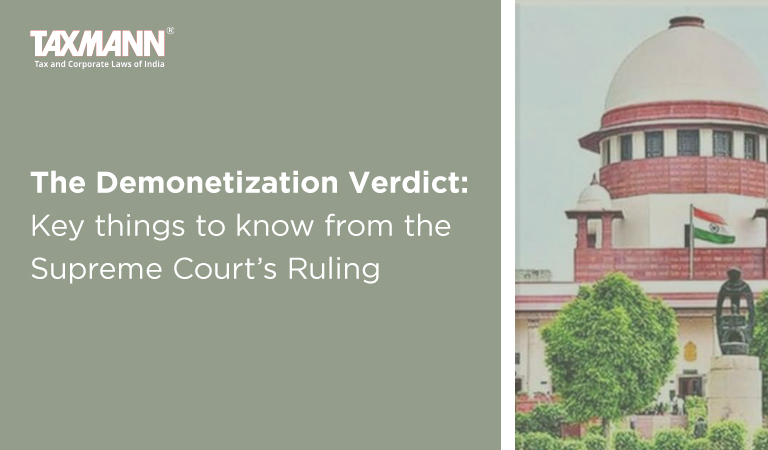The Demonetization Verdict: Key things to know from the Supreme Court’s Ruling
- Blog|News|FEMA & Banking|
- 3 Min Read
- By Taxmann
- |
- Last Updated on 4 January, 2023

The larger bench of five judges of the Supreme Court, on the first working day of the Year 2023 delivered a landmark ruling upholding the Central Government’s 2016 year’s decision on demonetization of Rs. 500 and Rs. 1000 currency notes a 4:1 majority. The Apex Court has laid down some key principles/observations while delivering the judgment. This write-up summarizes the key points that were considered by the Supreme Court.
1. Centre has the power to demonetize all series of banknotes
The question that arose for consideration before the Court was whether the powers of the Central Government u/s 26(2) of the RBI Act, 1934 to demonetize banknotes is restricted to only one or specific series.
Section 26(2) read as follows –
“On recommendation of the Central Board the Central Government may, by notification in the Gazette of India, declare that, with effect from such date as may be specified in the notification, any series of bank notes of any denomination shall cease to be legal tender [save at such office or agency of the Bank and to such extent as may be specified in the notification.”
The Supreme Court held that the power available to the Central Government u/s 26(2) of the RBI Act, 1934 cannot be restricted to mean that it can be exercised only for one or some series of banknotes and not for all the series of bank notes. The Supreme Court further said that if the restricted meaning is given to the word “any” it would lead to an absurd situation. Thus, the power can be exercised for all the series of bank notes.
2. Government power to demonetize u/s 26(2) of RBI Act doesn’t amount to excessive delegation
The Court noted that the RBI Act was enacted for the purpose of taking over the management and regulation of the currency from the Central Government as per Section 3 of the RBI Act. The preamble of the RBI Act also states that the RBI has been constituted to regulate the issue of bank notes.
The preamble of the RBI Act read with section 3 provides sufficient guidance to the delegate Central Government for exercising its powers. Further, the nature of the body to whom the delegation is made also needs to be taken into consideration. Thus, the delegation is made to the Central Government and not to any subordinate office.
3. Impugned Notification Dated Nov 8, 2016, satisfies the test of proportionality
The impugned notification dated November 8, 2016 declared that the banknotes of the existing series of denominations of the value of Rs 500 and Rs 1000 (hereinafter referred to as the specified bank notes), would cease to be legal tender on and from the 9th November, 2016. This means that they will no longer be accepted as a valid form of payment nor legally recognized as a form of currency.
The Apex Court held that Demonetization satisfies the test of proportionality. The test of proportionality refers to whether the benefits of demonetization outweigh the costs. To satisfy the test of proportionality, the benefits of demonetization must be significant enough to justify the costs and disruptions that it may cause.
Demonetization had a reasonable nexus with the objectives (i.e. eradicating black marketing, terror funding etc.) sought to be achieved. It is not relevant whether the objectives were achieved or not.
Click Here To Read The Full Article
Disclaimer: The content/information published on the website is only for general information of the user and shall not be construed as legal advice. While the Taxmann has exercised reasonable efforts to ensure the veracity of information/content published, Taxmann shall be under no liability in any manner whatsoever for incorrect information, if any.

Taxmann Publications has a dedicated in-house Research & Editorial Team. This team consists of a team of Chartered Accountants, Company Secretaries, and Lawyers. This team works under the guidance and supervision of editor-in-chief Mr Rakesh Bhargava.
The Research and Editorial Team is responsible for developing reliable and accurate content for the readers. The team follows the six-sigma approach to achieve the benchmark of zero error in its publications and research platforms. The team ensures that the following publication guidelines are thoroughly followed while developing the content:
- The statutory material is obtained only from the authorized and reliable sources
- All the latest developments in the judicial and legislative fields are covered
- Prepare the analytical write-ups on current, controversial, and important issues to help the readers to understand the concept and its implications
- Every content published by Taxmann is complete, accurate and lucid
- All evidence-based statements are supported with proper reference to Section, Circular No., Notification No. or citations
- The golden rules of grammar, style and consistency are thoroughly followed
- Font and size that’s easy to read and remain consistent across all imprint and digital publications are applied





